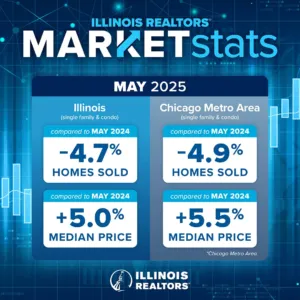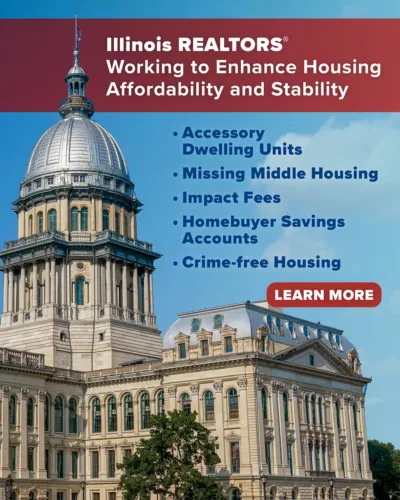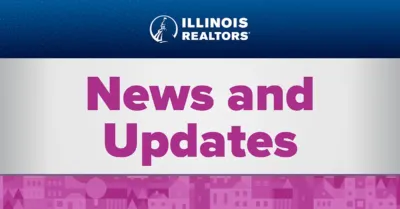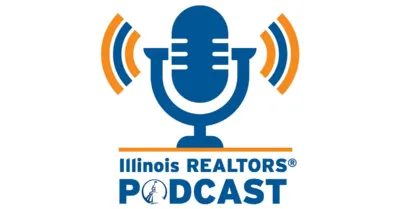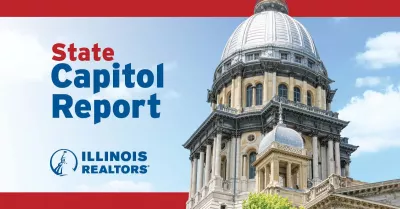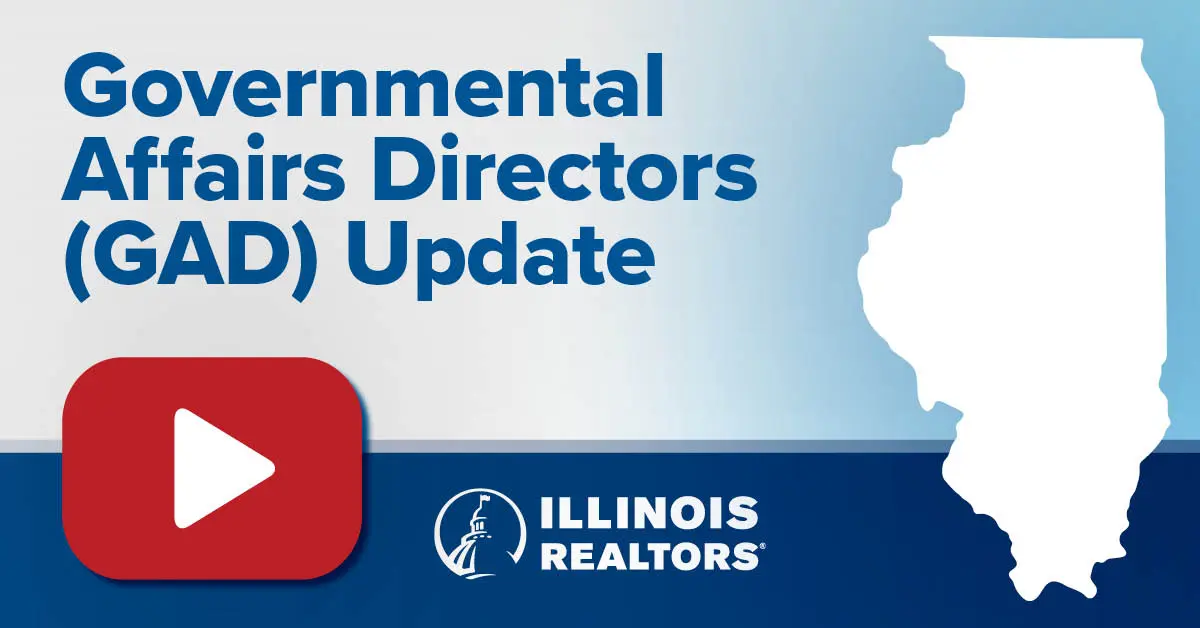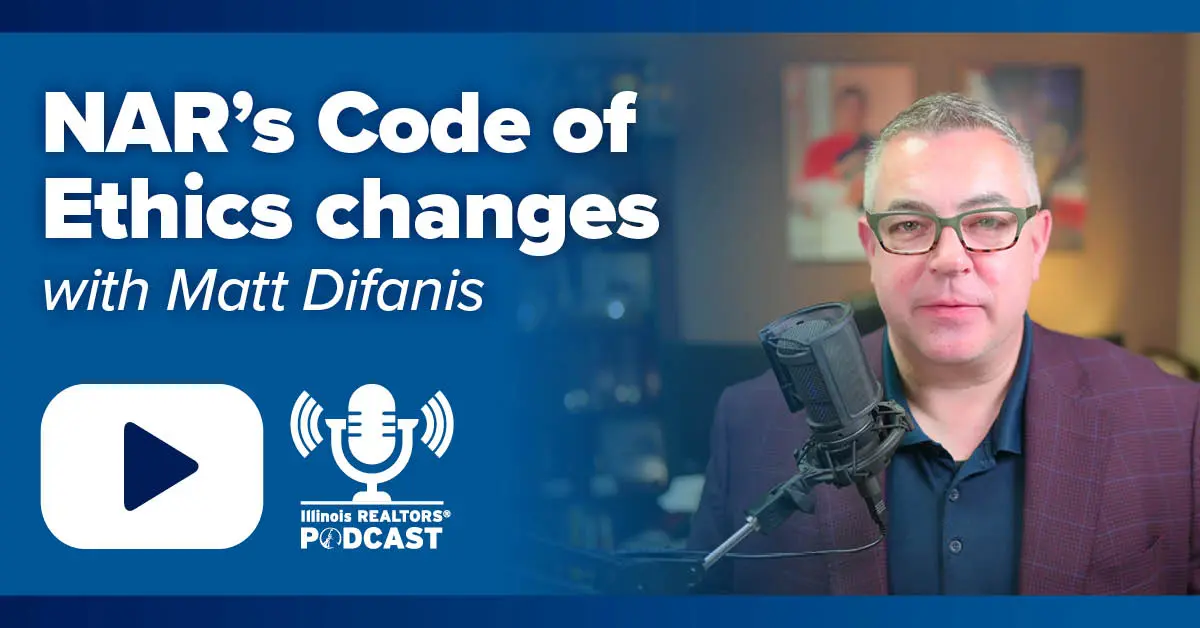The Regional Economics Applications Laboratory (REAL) at the University of Illinois developed a special, six-month forecast looking at what to expect in the Illinois housing market in the second half of 2021. Look for median prices to increase while home sales fall more in line with 2020 levels.
Find the six-month forecast and watch this video with Dr. Geoffrey J.D. Hewings as he discusses the trends shaping the market, shares news about changes in the U of I forecasting team and introduces his successor, Dr. Dan McMillen.
*Illinois REALTORS®, we want to hear from you. If you have any questions about market trends after watching this video, please send them to [email protected]
Full transcript:
Introduction: Hello. And welcome back to the Illinois REALTORS® podcast. This week, we have a very special episode for you. Our Director of Marketing, Stephanie Sievers, recently sat down with Dr. Geoffrey J.D. Hewings to discuss the six-month 2021 Quarter quarter three and four forecast for the Illinois housing market. In the second half of the interview, Dr. Hewings also introduces us to Dr. Dan McMillen, who will be taking over the leadership of the forecasting team. With all that on the docket, let’s not waste any more time. Stephanie, take it away.
Stephanie Sievers: I’m Stephanie Sievers and for the last 10 years, I’ve been working with Dr. Geoffrey Hewings to provide our members and the public with information on Illinois housing stats. The first half of the 2021 housing market has been unlike any other. We recently sat down with Dr. Hewings to talk about what is happening in the Illinois housing market now, and get an idea of what to expect through the end of the year. He will also share information about changes to the forecasting team and introduce you to Dr. Dan McMillen who will be taking over next month. Welcome Dr. Hewings and Dr. McMillen. With everyone watching for trends in the housing market, you created a six-month forecast looking through the end of the year. What can we expect in terms of home sales and prices?
Dr. Geoffrey J.D. Hewings: We have been looking at the next six months to see what is likely to change and what is likely to stay the same. And essentially, our analysis reveals that the continuation of the current trends is probably the most likely outcome with the exception that we’ll see the usual end of the year decline in sales volume. This happens almost every year and price changes will probably mute a little. They will still be positive, but they will not be as large as they have been in the early and mid-part of 2021.
Stephanie Sievers: Is the market cooling? And what is happening in terms of consumer sentiment about the market?
Dr. Geoffrey J.D. Hewings: The market has remained relatively hot, to use the current term, and consumers seem to be remaining positive. But what we’ve noticed is that the media tend to jump on a single month. And if they see something going down a little, is this a doom and gloom indication that things are going to decline rapidly? But I think the most interesting part of the market right now is this enormous gap between consumers who are interested in buying, and consumers who are interested in selling. And there’s a gap of around 14 percentage points with those who want to sell feeling much, much more optimistic about the market, than those who want to buy.
And on the other hand, when we look at the non-housing part of the market, we’ve seen in the last month, a slight decrease in consumer retail spending. But this probably reflects the fact there was an upsurge, and that is unlikely to be maintained and consumers are going back and behaving as more normally. The only difficulties that they are noticing is that there are huge inventory problems for things like consumer appliances, and we have been reading a great deal about the problems with ship availability for new car production. But apart from that, I think the market is reasonably stable at this time.
Stephanie Sievers: Monthly sales totals can fluctuate. What should we take away from a one month decline?
Dr. Geoffrey J.D. Hewings: I would be very hesitant to extract any long-term trend from a month-to-month change. If it is, it’s a very small change, a 1 percent decline is not dramatic. If that continues for the next two or three months, then I think we might begin to talk about a market that is beginning to cool, but I think we have to be very cautious because as you know, when the data are recorded, sometimes there’s a lot of activity towards the end of one month that sort of dampens the activity for the following month. And so looking at longer term, I think is much more important than looking at a month to month change.
Stephanie Sievers: How does the 2021 market compare to 2020?
Dr. Geoffrey J.D. Hewings: The market in 2020 was probably the most crazy of the 14 years that I’ve been looking at this, in the sense that we had this enormous downturn in March and April, and then it just went off and grew at an enormous rate. The one major difference is that the inventory was much higher in 2020 than it has been and what we’ve seen is a continuation of price increases, the continuation of increases in sales, but a significant decrease in the inventory levels. I think this is probably one of the major concerns in the market right now. If sales begin to decline, it may not be an indication that people are softening about their attitudes towards the market, but they’ve just become a little frustrated that they can’t find properties that they want to buy.
The amount of variety available is not very high. And I think this is a real concern. One of the things that I think is interesting about this market is that with low interest rates, you would expect a lot of demand, and that has certainly been the case. But a lot of that demand is coming from people who are refinancing, and over 50 percent of mortgages that were issued last month were refinanced. The other aspect of this is sort of interesting, that’s sort of accelerating the demand is the fact that Fannie Mae has now announced that in any underwriting decisions in the future, they’re going to take into account an applicant’s rental history. And if they’ve had a very good history that will result in them getting much higher ratings. So this is a real incentive to attract more people, in particular rentals, into a market which is already suffering from very, very tight inventory.
Stephanie Sievers: Available inventory has steadily declined over the last few years. What’s causing that decline? When can we expect inventory to improve?
Dr. Geoffrey J.D. Hewings: I think that there’s no one reason, but I think probably the most dramatic thing that has happened here is in contrast, when we came out of the 2008, 2011 recession, we had as much as 18 months of inventory on the market in any one given month. That took a number of years to remove, but we were already beginning to see tight inventory at the start of 2020. So this has been a continuation of the trend with the inventory rates over the last year that declined anywhere from 30 to 50 percent from already low levels to even lower levels. So I don’t think there’s any expectation that this is going to change very much over the next six months because the supply of new houses is dampened, we have a lot of people who have become risk averse, and they don’t want to enter the market right now. Even more importantly, I think we have a lot of people who are looking at the market, they want to maybe upgrade the house, they want to move to a larger house or to a different location and they just don’t find the variety of properties that they want to move to, so they’re staying put. So all of these things are dampening the supply side, but the demand side is continuing to grow in terms of demand. So this is putting that tension, which is probably largely responsible for the uptick in prices.
Stephanie Sievers: Available inventory has fallen as low as a 1.7 months supply, statewide. What’s considered a healthy supply?
Dr. Geoffrey J.D. Hewings: That’s the question that I really have not thought about as to say, “Oh if we get to this level, it’s healthy.” But when I look back at the last several years, it seemed to me that somewhere between three and six months seems to be a sort of a comfortable level. But the problem is that you’ve got different availabilities even during those times in terms of price points. So one of the things that we’re noticing right now is for properties over $700,000 in Chicago, you’ve got an inventory which is four or five months in length. Whereas the overall inventory for Chicago is 1.7 months. And then when you look at the lowest priced houses, you have inventories of 1.1 month, and all of those rates are about half what they were this time last year.
Stephanie Sievers: Is the market seeing different trends at different price points?
Dr. Geoffrey J.D. Hewings: Not really. I think when we look at the price points, I think the inventory problem is pretty similar. It’s 1.2 to 3.4 (months), which is not a humongous range, except for the highest price where they are around four months. But these inventory levels, I think reflect a couple of real concerns, that the price escalation has essentially removed a lot of properties from the lowest level. You’ve got two problems. One is the supply has shrunk because people are not putting their properties on the market, but the values of those properties has increased so that the house that was $180,000 is now $220,000. And this is really going to dampen the ability of a lot of first-time buyers to enter the market, because even with low interest rates, they may not be able to qualify even for one of the lowest priced houses. So that makes it very, very difficult for new people to enter the market. It’s good news for people who are wanting to sell their properties because they’re getting much more than they anticipated. On the other hand for new entrance to the market, it is dampening their ability to affect a transaction.
Stephanie Sievers: With forbearance agreements and eviction moratoriums coming to an end, what could that mean for the Illinois foreclosure activity? Is there a backlog of foreclosure cases that could impact the market and how might that compare to previous foreclosure spikes in years past?
Dr. Geoffrey J.D. Hewings: We’ve been monitoring the foreclosure activity, and in the last six or seven months the inventory has begun to rise again. It’s way below the levels that we saw at the end of the Great Recession, and certainly given the legal procedures involved in Illinois, even increases in foreclosure filings will not result in properties coming to the market, perhaps for several years. It sometimes takes as long as six years. The other aspect of this is that a lot of people are very concerned about the forbearance requests. And last month, the Mortgage Bankers Association announced that they had been declining for the last 19 months and in June, they had dropped below 2 million. The interesting question here is, what about those that are remaining? How many of those are going to be solved satisfactorily, where the renegotiation of the mortgage or the mortgage rates? Or will they end up going into that foreclosure inventory?
And that’s unknown. We don’t have any information about the characteristics of those properties that are still currently in full forbearance. But clearly I think the inventory problem is not going to be solved by an increase in foreclosures, especially in the short run. I think it was just when these finally get adjudicated through the legal process and they come to market. That’s very difficult, because one of the students we had employed made it the focus of her dissertation, and there was enormous variance in the time but it seemed that six years was sort of the upper end of the range and four years was something around the median for the activities. But some of them were adjudicated very quickly, others took even longer. And so trying to forecast the length of time they go through the legal process is very difficult. As you know, last year, a lot of legal activity was halted because the courts were closed. So we may have a backlog coming, starting through the process, but it’s really not going to make a significant difference to the inventory over the next six to nine months.
Stephanie Sievers: Finally, the University of Illinois forecasting team will be transitioning from its original home at the Champaign-Urbana campus to the Chicago campus under the direction of Dr. Dan McMillen. Dr. McMillen is the head of the Stuart Handler Department of Real Estate at the University of Illinois Chicago Business School. Dr. Hewings, can you talk to us about that transition?
Dr. Geoffrey J.D. Hewings: After 14 years of doing this work for you, we wanted to explore an orderly transition to a new team while trying to retain the opportunity for Illinois REALTORS® to work with the University of Illinois. While it has been my great pleasure to oversee this service, I just want to thank you for your support that has underwritten the research careers of many University of Illinois graduate students, many of whom are now enjoying careers in academia, in the private sector, and the most recent one with the Federal Reserve Bank of Richmond. Their access to the housing data has been instrumental to their successes. We are therefore delighted that Professor Dan McMillen has agreed to lead a new team from his space in the real estate department at the University of Illinois at Chicago. Dan is one of the world’s leading urban economists, and over his career has focused a great deal of his research on the housing market in Chicago. The new team of research assistants is already in place, so let me introduce you to Dan, who would like to say a few words of introduction, Dan?
Dr. Dan McMillen: Well, thank you. I want to thank Geoff and all of you for the opportunity to do this.
I’ve been at the University of Illinois since 1999. I’m one of the few people I think, who spent time back and forth between the two main campuses. I spent 1999 to 2008 in Chicago and then I went down to Champaign-Urbana until 2018, and then I’ve been back since 2018 in Chicago, where I got the opportunity to head the new Stuart Handler Department of Real Estate, which was formed at the University of Illinois in Chicago (UIC). One of the things that we really wanted to do at the new Department of Real Estate at UIC is to develop a program and a reputation that’s based on Chicago area and Illinois research. I just think this is a wonderful opportunity.
Dr. Dan McMillen: What we’re going to be doing is having a major in Real Estate that we hope to attract quite a few students from the College of Business, and it’s going to be a Chicago-focused curriculum. I think this is a wonderful opportunity to have this sort of practical experience in monitoring the market that will help with our program and hopefully allow us to help Illinois REALTORS® also. We have five real estate economists in our department. I’m the most Chicago-focused of them, but they all have a strong interest in Chicago area research. I’m really looking forward to continuing this. I’m really excited about the opportunity. I want to thank Geoff and everybody for allowing us to do this. And I look forward to working with you.
Host: Thank you for listening. Remember to like, share and subscribe to Illinois REALTORS® on all the major social media platforms. And of course, go in and give us a rating and a review on your podcast app of choice. And of course, if you’d like to know more from the Illinois REALTORS®, you can go to our website at www.IllinoisRealtors.org.

